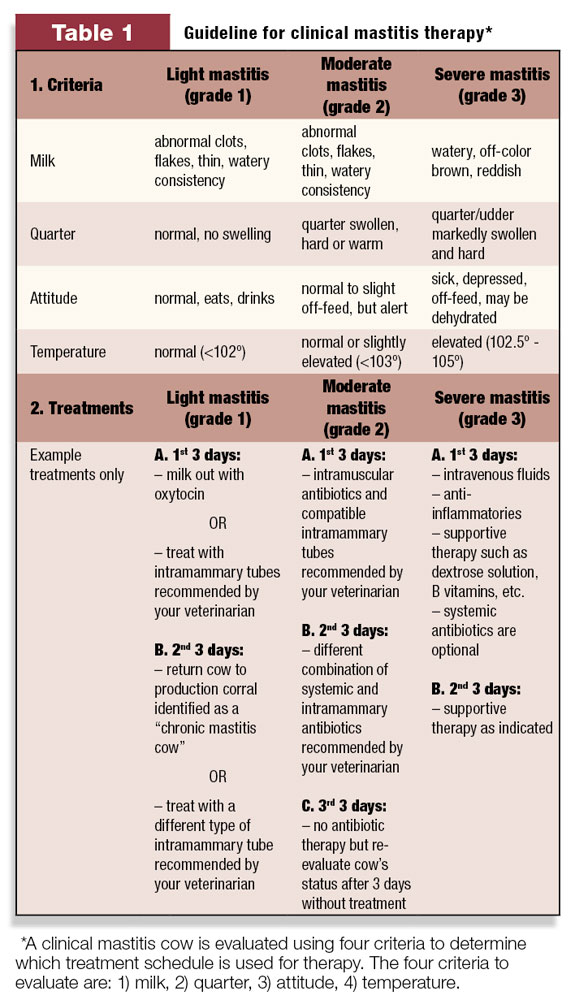“Great herdsmen rely upon more than just their skill and experience; they depend upon their attitude …to do things right all the time.” This is the theme of an article I wrote for your herdsman in the May 2011 issue of El Lechero. While you give lots of responsibilities to your herdsman, making decisions may be the most difficult part of his job. If he is a “good cowman,” then helping him decide if, when and how to treat sick cows requires that you provide guidelines, training and support for him.
Let me use the example of treating mastitis cows to offer tips to help you help him do the best job all the time.
Decision 1: To treat or not to treat
First, if you haven’t done so recently, compute breakeven milk for your dairy. Your herdsman may be surprised to learn the cow producing 50 pounds of milk is not profitable and may not be worth treating.
Second, determine other criteria you want your herdsman to base treatment decisions on. Pregnancy status, days in milk and number of health events in this lactation are some examples.
Then set criteria (write out and communicate in Spanish if necessary) for how you want your herdsman to use this information to make decisions. Here is an example:
1. First incidence of mastitis this lactation: Treat every cow
2. Second incidence: Treat unless:
• Cow gives less than 50 lbs of milk and not pregnant
• Cow gives less than 60 lbs of milk and is pregnant less than three months
• Cow has only three quarters
3. Third incidence: Treat only if:
• Cow gives greater than 70 lbs of milk and is pregnant
• Cow gives greater than 50 lbs of milk then dry off infected quarter
• Cow gives less than 50 pounds of milk then put on list to cull
4. Fourth incidence:
• Cow gives more than 70 lbs of milk and pregnant then dry off infected quarter
• All others, put on list to cull
The details of this example may not be appropriate for your business, but it illustrates how you can devise a guide for your herdsman to make decisions based on criteria he would otherwise not have much knowledge of. And while there are a lot of gray areas in this example, use those to require your herdsman to come to you with questions.
The more both of you evaluate the cows “in the gray area” together, the more he will come to understand your culling philosophy. He’ll use criteria to arrive at a logical conclusion, which is the process to make correct decisions.
Decision 2: Follow treatment protocols
I see many dairies where treatment protocols exist but are not followed accurately. Many experienced and well-intentioned herdsmen “know better” and ad lib regarding dosages of antibiotics, route of administration and adding other medications to a basic protocol.
A way to capitalize on a herdsman’s experience while focusing him on following protocol is to require that he make a diagnosis and grade the severity of a health problem. For example, don’t write a protocol for coliform mastitis (an impossible diagnosis without laboratory results).

Rather, write the protocol for “mastitis, grade 3.”
Establish the criteria for the three grades of mastitis (see the sample mastitis therapy chart to the right ), then write the treatment protocol which adds additional supportive therapy for each grade.
This approach draws upon your herdsman’s experience (diagnostic ability and recognition of the severity of the problem) but still maintains control of treatment costs (supportive therapy is relatively inexpensive but immensely valuable to the recovery of severely sick cows).
It also limits residue potential (the part of the protocol that cannot be changed), because most supportive therapy has little residue risk.
Herdsmen are the initial decision-makers for treating sick cows. Most are unaware of the economic factors necessary to make correct culling or treatment decisions.
In addition, they may not be aware of the residue risk incurred when using medications outside of veterinary prescribed protocols.
These tips may improve your communication with your herdsman and provide the facts and guidelines he needs to make correct decisions all the time.
Protocol compliance, residue avoidance and profitability are in the hands of your herdsman. PD

Tom Fuhrmann
Vet/President
DairyWorks
cowdoctf@aol.com





